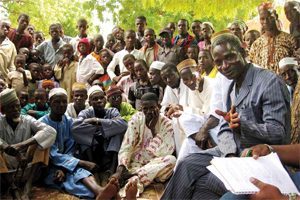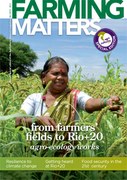Although the 2012 UN International Year of Cooperatives is half‑way through, it has already contributed much to showing the importance of farmers’ organisations. Collective action by farmers is very much needed, especially when farms are (or will become) too small to be attractive to trading partners.

Successful collective marketing has built organisational assets that make their life easier. Farmers’ organisations regularly fine-tune their internal management and aspects of their transactional relationships (with members and non-members), relating to pricing, payments and quantity or quality requirements. Through learning-by-doing processes, they have developed internal rules, contract conditions and control systems that have proven to be effective and feasible in the prevailing market conditions.
The ESFIM programme (Empowering Smallholder Farmers in Markets) tries to capture and share this knowledge through a website and database containing specific case-studies (www.collectivemarketing.org). This website provides crowd-sourced knowledge on internal organisational regulations that can make life easier, providing solutions to common challenges that groups face when developing their marketing activities. As these solutions will always be contextspecific (depending on the product, the support of institutions, or the scale of the organisation), this crowd-sourcing is facilitated by a comparative framework that helps others to find solutions or lessons relevant to specific types of challenge.
Challenging the tensions that can break organisations
| Fair pricing | The members expect that a fair price will be negotiated on their behalf by their organisation. The group’s stronger bargaining position should translate into better terms than members could have negotiated on their own. This creates the need for a mechanism that creates transparency in price determination. |
| Quality assurance | When a deal is made, there is a need to control the quality that the organisation has promised. Individual members may try to deliver lower quality produce and the organisation needs a system to maintain minimum quality requirements. |
| Coping with working capital constraints | Many farmers face cash constraints and want fast payments, while the organisation needs time to finish transactions with the end buyer. This creates financial costs for the group as they need to have a working capital to pay farmers quickly. |
| Anticipating “side selling” | The organisation might provide a credit service or advance payment system to enable production. However, this entails a serious risk that farmers will “side sell” their produce to competing traders or processors, to whom they have no repayment obligation. |
| Distributing profits | When the organisation makes a profit, it will prefer to invest or increase its capital reserves, while the members will prefer shorter term benefits, e.g. better prices. |
| Differentiating services to members and non-members | Most economic organisations need contributions from members to achieve their business targets. However, members can sometimes be deterred from making such contributions if the benefits from the group’s activities accrue to both investors and non-investors. |
| Task delegation and supervision of professional staff Most farmers’ organisations employ professional staff | Most farmers’ organisations employ professionals staff to support them. Board members need to have proper information to make good decisions. This means that staff must be transparent and willing to provide this information. At the same time, however, decisions about commercial transactions often need to be made quickly, and professional staff need to have sufficient autonomy to make these decisions. |
Collective marketing is characterised by a number of basic tensions. All organisations will be affected by some of these tensions, though they will not necessarily experience them as being problematic.
Typically, a farmers’ organisation will only become aware of them at times of change or crisis, when decisions have to be made to resolve problems, prevent damage, or to mediate conflicts – factors which force them to redefine their internal regulations.
By organising their experiences according to the type of tension, we facilitate a process whereby users can find useful lessons on those aspects that are most relevant to them at that particular point in time.
By searching for and double-clicking on an experience that seems interesting to them, more detailed information will appear, with the reference to the document or source describing the experience. These are not presented as “best practices”, but as “inputs for learning”.
The box (right) presents eight areas where the tensions between members and the organisation tend to be found and which, if badly handled, may even cause the disintegration of the group.
Many organisations have found (often quite innovative) ways to overcome these threats to group cohesion: solutions that may inspire other organisations to implement similar approaches to resolve their specific challenges.
ESFIM is looking for examples of this organisational intelligence to add to the www.collectivemarketing.org website. Many practitioners who work with farmers’ organisations may already have such information at their disposal, as most project activities are internally documented.
We ask you to share these stories with us. They can be sent to giel.ton@esfim.org. All quality submissions will be included on the website. The most relevant examples will be considered for inclusion in a planned hard-copy publication.
We welcome unstructured stories and will extract the relevant organisational solutions for the database and website.
However, we would welcome even more stories that document how farmers’ organisations have coped with these tensions, and which highlight the following features:
- The context: tell us about the group’s activitiess and the problems that led them to come up with their solution.
- The mechanism: tell us about the organisational mechanisms used to resolve the tensions between group and individual interests.
- The outcome: what was the result of the introduction of the mechanism? How did it change the behaviour of the members, or affect the way that the group performed its functions and activities?
- An evaluation: would you recommend this solution to other farmers’ organisations? Are there any preconditions to be met in order to introduce and use this mechanism? Or, can you suggest better ways to cope with similar problems?
Join and contribute to ESFIM by submitting your stories!
Text: Giel Ton
Giel Ton works as senior researcher at the Agricultural Research Institute (LEI), Wageningen, and is co-ordinator of the ESFIM programme (www.esfim.org).
E-mail: giel.ton@esfim.org


